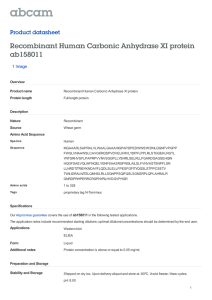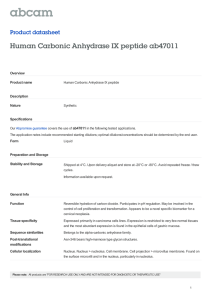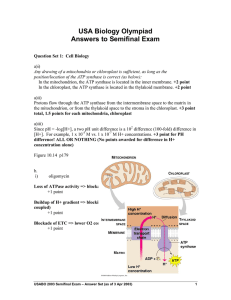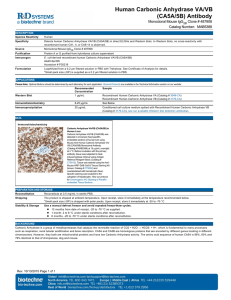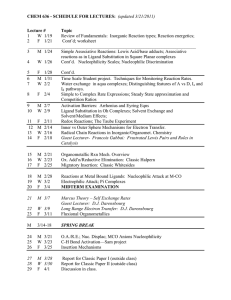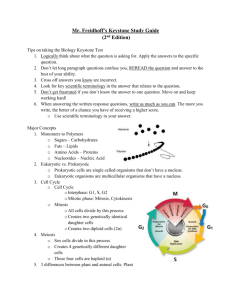Question Set 1: Cell Biology
advertisement
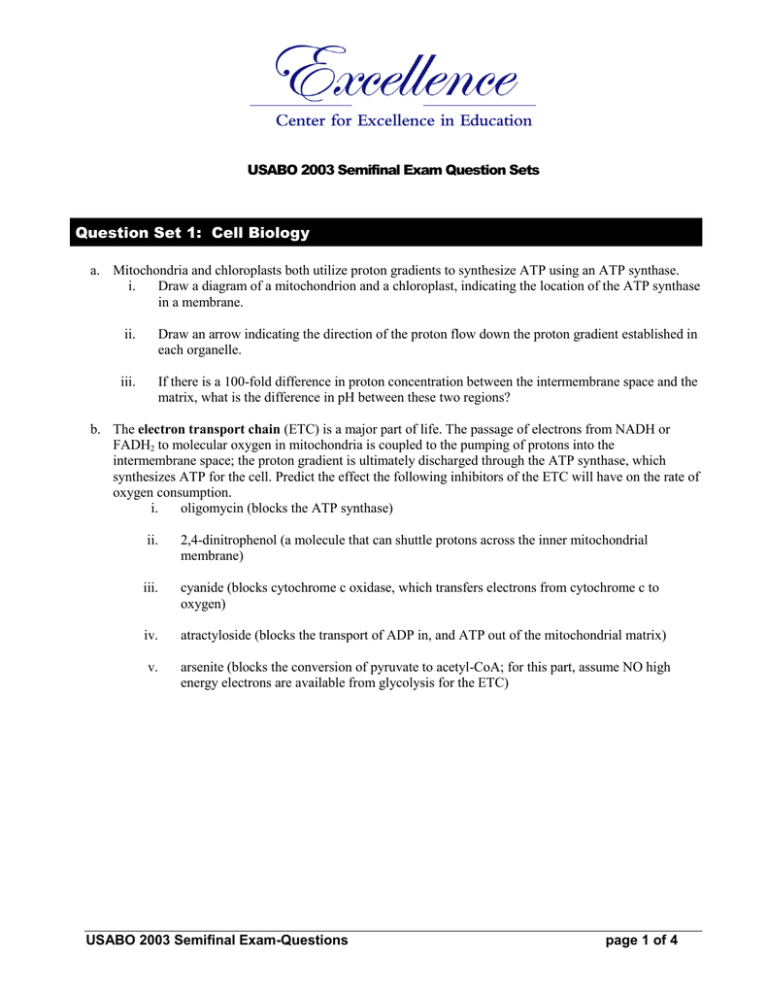
USABO 2003 Semifinal Exam Question Sets Question Set 1: Cell Biology a. Mitochondria and chloroplasts both utilize proton gradients to synthesize ATP using an ATP synthase. i. Draw a diagram of a mitochondrion and a chloroplast, indicating the location of the ATP synthase in a membrane. ii. Draw an arrow indicating the direction of the proton flow down the proton gradient established in each organelle. iii. If there is a 100-fold difference in proton concentration between the intermembrane space and the matrix, what is the difference in pH between these two regions? b. The electron transport chain (ETC) is a major part of life. The passage of electrons from NADH or FADH2 to molecular oxygen in mitochondria is coupled to the pumping of protons into the intermembrane space; the proton gradient is ultimately discharged through the ATP synthase, which synthesizes ATP for the cell. Predict the effect the following inhibitors of the ETC will have on the rate of oxygen consumption. i. oligomycin (blocks the ATP synthase) ii. 2,4-dinitrophenol (a molecule that can shuttle protons across the inner mitochondrial membrane) iii. cyanide (blocks cytochrome c oxidase, which transfers electrons from cytochrome c to oxygen) iv. atractyloside (blocks the transport of ADP in, and ATP out of the mitochondrial matrix) v. arsenite (blocks the conversion of pyruvate to acetyl-CoA; for this part, assume NO high energy electrons are available from glycolysis for the ETC) USABO 2003 Semifinal Exam-Questions page 1 of 4 Question Set 2: Animal Physiology In this question, we consider the buffering system of the blood, and how both the renal and circulatory systems deal with pH homeostasis. The central buffering system in the blood is based on carbonic acid, according to the chemical equation: CO2 + H2O H2CO3 HCO3- + H+ Note that the “” signs in the reactions imply reversibility; in other words, carbon dioxide and water can combine to form carbonic acid, and carbonic acid can also decompose to water and carbon dioxide. The first reaction is mediated by the red blood cell enzyme carbonic anhydrase. a. What is the function of carbonic anhydrase? Does carbonic anhydrase catalyze the decomposition of carbonic acid to water and carbon dioxide, as well as carbonic acid formation? What effect will increasing temperature (e.g. in a fever) have on carbonic anhydrase activity? b. Suppose that we found a small molecule that bound the carbonic anhydrase at its active site. (Assume carbonic anhydrase has only one active site.) What is the mode of inhibition of this inhibitor? Draw the resulting initial reaction velocity versus substrate concentration and a reciprocal plot (1/reaction velocity versus 1/substrate concentration) graphs in the presence and absence of the inhibitor. Will increasing the concentration of CO2 and H2O overcome this inhibition? Explain. c. Assume you’re a doctor. A patient comes to your clinic who has a carbonic anhydrase enzyme deficiency? What phenotype would you expect him or her to have? (To a first approximation, what would you expect the partial pressure of carbon dioxide in their blood to be?) Explain. d. Hemoglobin (Hb) cooperatively binds the oxygen in blood by the following equation: HbH + 4O2 Hb(O2) 4 + H+ Draw a curve relating the oxygen saturation of Hb to the partial pressure of O2 in the blood. Using this curve, explain briefly the concept of cooperativity. Hb is sensitive to changes in the pH of the blood. If we assume that the chemical equation written above completely describes how Hb and pH are related, how would an increased respiratory rate affect Hb's affinity for oxygen molecules? Explain your answer. e. BPG (2,3-bisphosphoglycerate) is a metabolic product of glycolysis found in red blood cells. It decreases the affinity of Hb for O2. What levels of BPG would you expect in (i) a person living at high altitudes and (ii) a newborn? Explain, using the saturation curve. USABO 2003 Semifinal Exam-Questions page 2 of 4 Question Set 3: Ecology & Biosystematics a. Describe the following adaptations in animals, and explain the adaptive significance of each: i. amniotic egg ii. bilateral symmetry iii. coelom iv. closed circulatory system v. complete gut b. For the traits listed above, which are present in the following animal phyla? i. Arthropoda ii. Cnidaria iii. Platyhelminthes iv. Mollesca c. Describe the difference in the fate of the blastopore during the development of protostome vs. deuterostome animals. Give two examples of phyla from each of these groups. d. In addition to the fate of the blastopore, describe any other differences in the early embryonic development of protostomes and deuterostomes. USABO 2003 Semifinal Exam-Questions page 3 of 4 Question Set 4: Evolution and Genetics A population has a two-allele system where allele A is the dominant phenotype and allele B the recessive phenotype. a. What is Hardy-Weinberg equilibrium? (Do NOT explain with an equation.) What conditions are required for Hardy-Weinberg equilibrium to exist? b. The frequency of allele A in our population is 60%. Calculate the frequency of allele B. What are frequencies of all possible genotypes for our population, assuming Hardy-Weinberg equilibrium? c. Now assume allele B is deleterious. Describe what happens to the allele and genotypic frequencies in the next generation if 50% of individuals with the recessive phenotype and 25% with the dominant phenotype die before reproduction. Will the recessive allele ever disappear? Why or why not? How would this scenario change if: i. Allele B were dominant? ii. There were a heterozygotic advantage? USABO 2003 Semifinal Exam-Questions page 4 of 4
